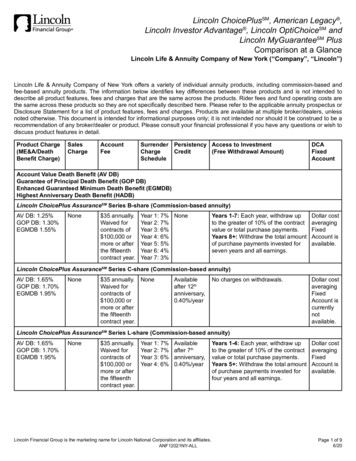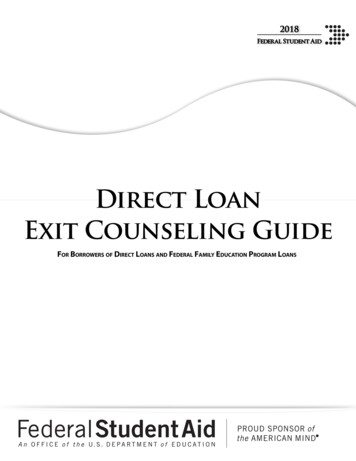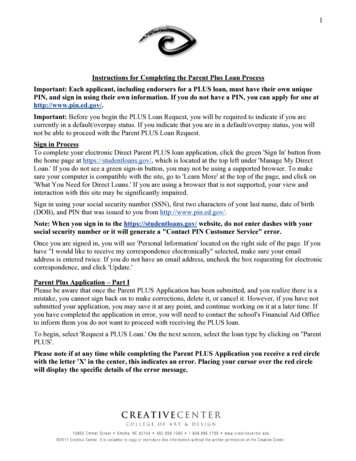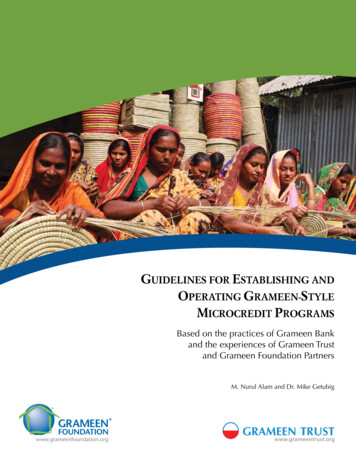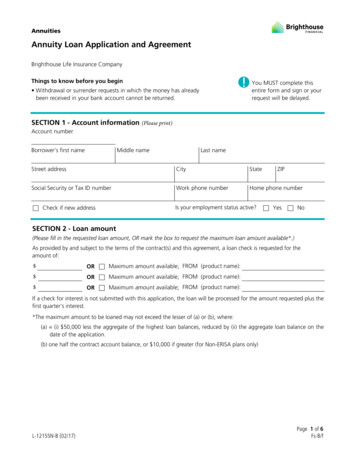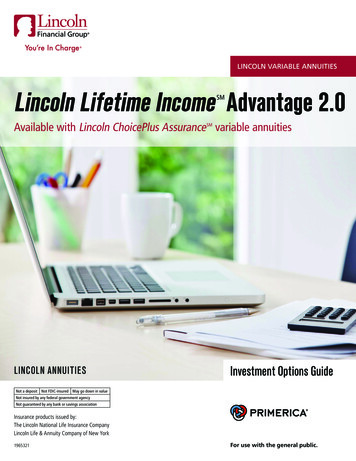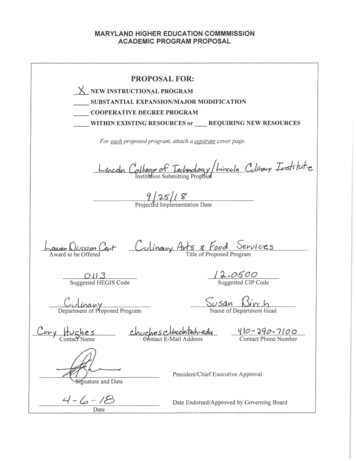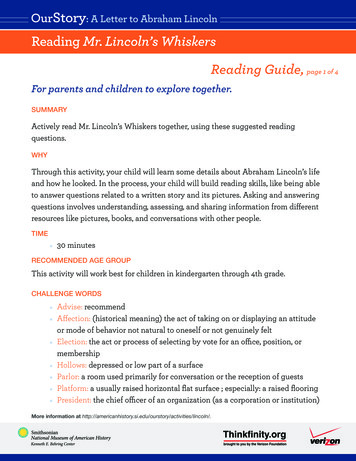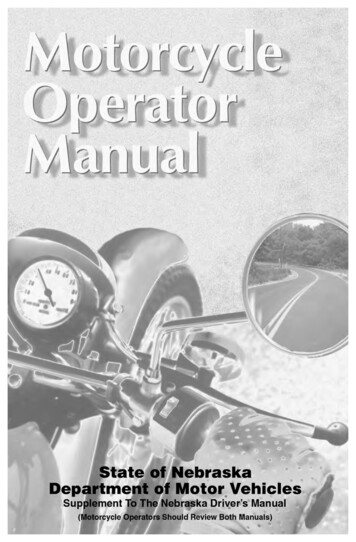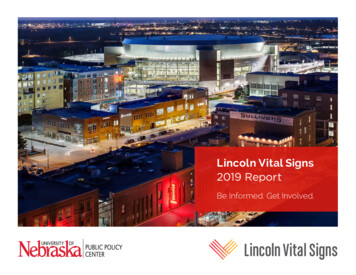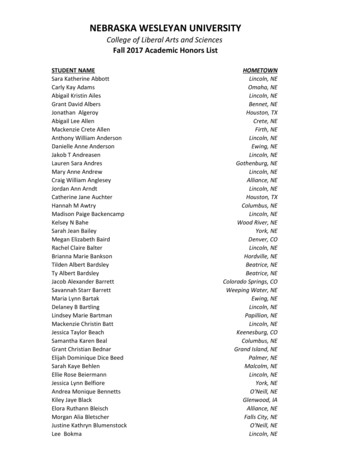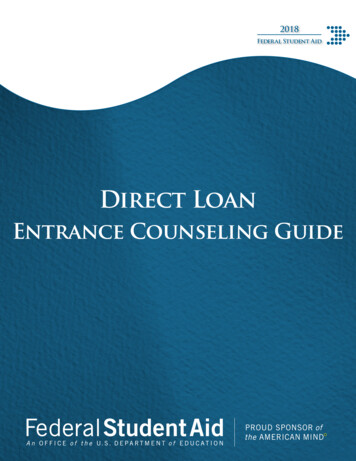
Transcription
2018Federal Student AidDirect LoanEntrance Counseling Guide
U.S. Department of EducationBetsy DeVosSecretaryFederal Student AidJames ManningActing Chief Operating OfficerFederal Student Aid, an office of the U.S. Department of Education, ensures that alleligible Americans benefit from federal financial assistance—grants, loans and work-study programs—for education beyond high school. By championing the promise of post secondary education, we upholdits value as a force for greater inclusion in American society and for the continued vitality of America as a nation.Need More Information, or Have a Comment?If you are a borrower with questions about the Direct Loan Program or your Direct Loans, you should contactyour loan servicer, or the websites or the offices described in the content of this publication.If you have general questions about the federal student aid programs,you may call the Federal Student Aid Information Center (FSAIC) at1-800-4-FED-AID (1-800-433-3243),TTY (for the hard of hearing) 1-800-730-8913,Locations without access to 800 numbers 1-334-523-2691.You can email FSAIC at studentaid@ed.gov.July 2016, revised August 2017 and July 2018.All URLs were last accessed on May 30, 2018.2018Direct Loan Entrance Counseling Guide
ContentsAbout This Guide. 1Terms Used in This Guide. 2The Direct Loan Program. 4Chart: Types of Direct Loans . 4Interest Rates in the Direct Loan Program. 5Loan Limits in the Direct Loan Program. 6Chart: Loan Limits in the Direct Loan Program . 7Credit Checks and Direct PLUS Loans. 7Half-Time Enrollment Requirement . 8Chart: Periods When Interest Accrues on Direct Subsidized Loans andthe 150 Percent Limitation . 8Loan Disbursements. 9150 Percent Limitation on Direct Subsidized Loan Eligibility. 9Chart: Do Changes in My Student Status Affect My Paying the Interest That Accrues onMy Direct Subsidized Loans?. 10Be Smart in Your Use of Financial Aid.11Repayment.12Chart: Repayment Plan Options for Direct Loans. 15Chart: Flexible Repayment Plan Options for Direct Loans . 16Chart: Estimated Monthly Payments for Direct Loans and FFEL Program Loans. 17Navigating Repayment.18Your Repayment Obligation—Avoiding Delinquency and Default.19Allowing Your Loan to Become Delinquent or To Go Into Default Can Have NegativeConsequences for Many Areas of Your Life.20Strategies for Avoiding Delinquency and Default.21Deferment.23Forbearance.24Loan Consolidation.24Loan Forgiveness and Discharge.25Resolving Student Loan Disputes.26Financial Planning and Debt Management.27Your Credit and Identity.28Financial Literacy.29Helpful Resources.30Student Contact Information and Acknowledgment.31Your Rights and Responsibilities as a Borrower.33Entrance Guide July 2018i
Direct Loan Entrance GuideKeep this publication and all other documents you receive associated with your Direct Loan in a safeplace. You will need to refer to them as you progress in and complete your postsecondary education.Important!You never have to pay for help with your student loans.Free assistance with managing your loans is provided by your federal loan servicer.There is a growing number of so-called commercial student loan debt relief companies thatclaim to offer assistance in managing your federal student loans for a fee. Despite what thesecompanies claim, there’s nothing a student loan debt relief company can do for you that youcan’t do yourself for free with the assistance of your federal loan servicer.If you ever need assistance, the Department of Education and our federal loan servicers willhelp you at no cost!For more information on avoiding loan scams, go g-loan-scams.If you’re having problems managing your student loans, contact your federal loan servicer orthe Federal Student Aid (FSA) Ombudsman Group.iiEntrance Guide July 2018
About This GuideThe Direct Loan Entrance Counseling Guide provides an overview of the William D. Ford Federal Direct Loan (Direct Loan)Program including information you’ll need to successfully repay the federal student loans that you’ll be receiving to help payfor your college costs. For additional information about many of the topics covered in this guide, see your Master PromissoryNote (MPN) or your copy of the Borrower’s Rights and Responsibilities Statement that accompanied your MPN.You can find this statement by going to https:// age mpnlogging in, scrolling down the page, and selecting either the PDF version of the Master Promissory Note (MPN) for DirectSubsidized or Unsubsidized Loans, or the PDF version of the Federal Direct PLUS Loan Master Promissory Note (MPN) for agraduate/professional student.What is Entrance Counseling?If you have not previously received a Direct Loan or Federal Family Education Loan (FFEL), the federal government requiresyou to complete entrance counseling to ensure that you understand the responsibilities and obligations you are assuming. Youmust complete entrance counseling before you can receive the proceeds of your first Direct Loan.If you are completing entrance counseling to borrow a loan as an undergraduate student, then the entrance counseling willfulfill counseling requirements for Direct Subsidized Loans and Direct Unsubsidized Loans. If you are completing entrancecounseling to borrow a loan as a graduate or professional student, the entrance counseling will fulfill counseling requirementsfor Direct Unsubsidized Loans and Direct PLUS loans.Who should complete entrance counseling?Federal law requires entrance counseling for students who have not previously received a subsidized or unsubsidized loan orPLUS loan (graduate/professional students only) under the Direct Loan Program or Federal Family Education Loan (FFEL)Program.What information do I need to complete entrance counseling? a verified FSA ID; the name of your school and the tuition, fees, and other charges you will be paying this year;You can find this information on your student account at your school. Your school’s student accounts office(often called the bursar’s office) can provide you with a paper copy of your student account or tell you how toview it online. the letter you may have received from your school’s financial aid office informing you of the financial aid it isoffering you. (It is often called an award letter); and details on your income, financial aid, and living expenses.How does one complete entrance counseling?You must complete the Direct Loan Entrance Counseling online at .Your school may have alternate entrance counseling requirements. Check with your school’s financial aid office to be sure thatthe counseling available on this website satisfies its requirements for entrance counseling.Entrance Guide July 20181
Direct Loan Entrance GuideTerms Used in This GuideNote: Throughout this guide, the words “we,” “us,” and “our” refer to the U.S. Department of Education. You will alsofrequently encounter the words “loan holder,” “loan servicer,” and “Master Promissory Note.” To assist you, weprovide the definitions for those and other terms within this publication.You can find an expanded glossary of terms at —Demand for immediate repayment of your entire federal student loan. The entire unpaid amount of yourfederal student loan becomes due and payable if you receive loan money, but don’t enroll at least half-time at the school that determined you were eligible to receivethe federal student loan; use your loan money to pay for anything other than expenses related to your education at the school thatdetermined you were eligible to receive the federal student loan; make a false statement that causes you to receive a federal loan that you’re not eligible to receive; or default on your federal student loan.Aggregate Loan Limit—A limit on the total amount of FFEL or Direct Subsidized Loans and/or Unsubsidized Loans that youmay borrow for undergraduate and graduate study. If the total amount you receive over the course of your education reachesthe aggregate loan limit, you will not be eligible to receive additional loans. However, if you repay some of your loans to bringyour outstanding loan debt below the aggregate loan limit, you could then borrow again, up to the amount of your remainingeligibility under the aggregate loan limit.Annual Percentage Rate (APR)—The actual yearly cost of borrowing money reflected as a percentage rate.Capitalized Interest (Capitalization)—Unpaid interest that has been added to the principal balance of a federal student loan.Future interest is charged on the increased principal balance, and this may increase the amount of your monthly payment andthe total amount you repay over the life of the federal student loan.Federal Student Loan—In this guide, loans made under the Direct Loan Program, Federal Perkins Loan Program, and theFederal Family Education Loan (FFEL) Program.FSA IDThe FSA ID, composed of a username and password, is used to log in to certainU.S. Department of Education websites and to electronically sign the FAFSA form.You created your FSA ID when you completed and electronically signed the FAFSA formthat you used to establish your eligibility for federal student aid. Your Direct Loan is one partof that aid.Grace Period—A period of time (generally six months) after you graduate or drop below half-time enrollment during whichyou are not required to make payments. The repayment period for your loan begins after the end of the grace period.Interest—The cost of borrowing money. Interest is calculated as a percentage of the outstanding (unpaid) principal balance.2Entrance Guide July 2018
2018Loan Discharge (Cancellation)—The elimination of a loan debt under certain limited circumstances.Loan Forgiveness—The elimination of a loan debt under one or more of the various Direct Loan forgiveness programs.Loan Holder—The U.S. Department of Education is your loan holder. Your loan servicer will be different than your loanholder (see below).Loan Servicer—An entity that collects payments on a federal student loan, responds to customer service inquiries, andperforms other administrative tasks associated with maintaining a loan on behalf of a loan holder. A loan servicer performs allservicing tasks on behalf of the U.S. Department of Education. A current listing of federal loan servicers for federally held loansmade through the Direct Loan Program can be found at d/servicers.Identifying Your Loan ServicerYou can identify the servicer for your new Direct Loan (and any subsequent Direct Loans) by goingto the National Student Loan Data System (NSLDS) website at www.nslds.ed.gov/nslds SA/, andlogging in with your FSA ID. The site will open to your Financial Aid History Page. Select one of yourloans to see the loan detail. In the section labeled “Make a Payment” you’ll find the loan servicer forthat specific loan.Principal—The loan amount you borrow plus any capitalized interestPromissory Note—A legally binding agreement that contains the terms and conditions of the loans made under the note. Mostfederal student loans are made under a Master Promissory Note (MPN).Master Promissory Note (MPN)An MPN is a binding legal document that you must sign before receiving your first Direct Loan.The same MPN can be used to make one or more loans for one or more academic years (up to10 years). Therefore, if you leave school and return, you may be able to receive additional loanswithout signing a new MPN. An MPN lists the terms and conditions under which you agree torepay the loan and explains your rights and responsibilities as a borrower. It’s important to readyour MPN and keep it in a safe place because you’ll need to refer to it later when you beginrepaying your loan or at other times when you need information about provisions of the loan,such as deferment or forbearance.Remember!For each federal student loan that you receive under an MPN, you’ll receive a disclosurestatement that provides specific information about that loan, including the loan amount,loan fees, and the expected disbursement dates and amounts. Other disclosures will beprovided to you throughout the loan process.Entrance Guide July 20183
Direct Loan Entrance GuideThe Direct Loan ProgramThrough the Direct Loan Program, the U.S. Department of Education provides the following loans to eligible students atparticipating schools: Direct Subsidized Loans, Direct Unsubsidized Loans, Direct PLUS loans, and Direct Consolidation Loans.You may receive more than one type of loan under the Direct Loan Program. Each loan type has its own terms and conditions,such as interest rates.You repay your Direct Loan to the U.S. Department of Education.Types of Direct Loans(Excluding Consolidation Loans)DirectSubsidized LoansWho may receivethis loan?Undergraduate students with financialneedDirectUnsubsidized LoansAll studentsDirectPLUS LoansPLUS loans are federal loans that graduate orprofessional students and parents of dependent undergraduate students can use to help pay for college orcareer school.PLUS loans can help pay for education expenses notcovered by other financial aid.When does thegovernment paymy interest? 1While you are enrolled, and for sixYou pay all interest charged overmonths after you graduate or drop below the course of your loan term.half-time enrollmentYou pay all interest charged over the course of your loanterm.Deferment periodsDuring certain periods of repaymentunder the Income-Based Repayment,Pay As You Earn, and Revised Pay As YouEarn plansWhen must Ibegin makingpayments?14Six months after you graduate or dropbelow half-time enrollmentSix months after you graduate ordrop below half-time enrollmentMost PLUS loans require you to start making paymentssix months after you leave school or drop below halftime enrollment. Graduate and professional studentborrowers with Direct and FFEL PLUS loans that werefirst disbursed on or after July 1, 2008, receive anautomatic deferment while in school and a six-monthdeferment after they graduate, leave school, or dropbelow half-time enrollment.If you are a borrower whose first loan is made on or after July 1, 2013, and you exceed the limits described in 150 Percent Limitation on Direct Subsidized Loan Eligibility on page 9 of this guide,you (instead of the government) may become responsible for paying the interest that accrues on your Direct Subsidized Loans during all periods.Entrance Guide July 2018
2018Interest Rates in the Direct Loan ProgramThe interest rates on Direct Subsidized Loans, Direct Unsubsidized Loans, and Direct PLUS loans are fixed rates that arecalculated each year in accordance with formulas specified in the laws and regulations that set the terms and conditions ofDirect Loans.When the rates are calculated, they apply to all loans for which the first disbursement (when funds are posted to your accountor delivered to you) is made during the period beginning on July 1 of one year and ending on June 30 of the following year.Each loan you receive over the course of your education may have a different fixed interest rate, depending on when the loan isfirst disbursed, the loan type, and whether you are an undergraduate student or a graduate or professional student.Each type of loan has a maximum fixed interest rate (or cap). The maximum interest rates are 8.25% on Direct Subsidized Loans made to undergraduates1 and Direct Unsubsidized Loans made toundergraduates; 9.50% on Direct Unsubsidized Loans made to graduate students; and 10.50% on Direct PLUS loans made to graduate and professional students, and parents of dependentundergraduate students.1Graduate and professional students are not eligible for Direct Subsidized Loans.How Interest AccruesDirect Loans are “simple daily interest” loans. This means that interest accrues daily. The amount ofinterest that accrues per day is calculated by dividing the interest rate on your loan (as a decimal)by the number of days in a year, and then multiplying that by the outstanding principal balance ofthe loan.For example, on a 10,000 Direct Unsubsidized Loan with a 6.8% interest rate, the amount ofinterest that accrues per day while the loan has an outstanding balance of 10,000 is 1.86,calculated as follows:(0.068 / 365) X 10,000 1.86How You Can Find the Interest Rates on Your LoansYou can find the interest rates for your Direct Loans by going to the National Student Loan DataSystem (NSLDS) website at www.nslds.ed.gov/nslds SA/ and logging in with your FSA ID. Thesite will open to your Financial Aid History page and you will see a record of the loans you’vereceived. By selecting one of the loans, you will be able to see the loan detail, including theinterest rate for that loan.Entrance Guide July 20185
Direct Loan Entrance GuideLoan Limits in the Direct Loan ProgramSubsidized and Unsubsidized Loan LimitsFor Direct Subsidized Loans and Direct Unsubsidized Loans, there are limits on the maximum amount you may borrow for anacademic year (annual loan limits) and the maximum amount you may borrow in total for undergraduate and graduate study(aggregate loan limits).The actual loan amount you are eligible to receive is determined by your school and is based on your academic year, gradelevel, whether you are dependent or independent, and other factors, such as the length of your program, your cost of attendance, your Expected Family Contribution (EFC), other financial aid you receive, and your remaining eligibility under the annual and aggregate loan limits.If you’re an undergraduate student, your annual loan limit will include both any Direct Subsidized Loans and DirectUnsubsidized Loans you receive for the same academic year period.Direct PLUS Loans and Loan LimitsDirect PLUS loans don’t have fixed limits.You can borrow up to the cost of attendance at the school you’re attending, minus all other financial assistance you receive.Your school will determine the actual Direct PLUS Loan amount that you are eligible to receive.Direct PLUS Loans and Eligibility for Other Financial AidA Direct PLUS Loan can affect your eligibility for other financial aid. Before applying for a DirectPLUS Loan, ask your school’s financial aid office about federal grants and work-study, state andprivate grants and scholarships, and Direct Subsidized Loans and Direct Unsubsidized Loans.Remember!If you’re a graduate or professional student, use Direct Unsubsidized Loans first, then use Direct PLUSloans, if needed. Direct Unsubsidized Loans offer the following advantages over Direct PLUS loans: Lower interest rates Lower fees6Entrance Guide July 2018
2018Loan Limits in the Direct Loan ProgramAcademic YearDependent Students (except studentswhose parents are unable to obtainPLUS loans)Independent Students (and dependent undergraduate students whose parents are unable toobtain PLUS loans)First-Year UndergraduateAnnual Loan Limit 5,500—No more than 3,500 of this amount 9,500—No more than 3,500 of this amount may be inmay be in subsidized loans.subsidized loans.Second-Year UndergraduateAnnual Loan Limit 6,500—No more than 4,500 of thisamount may be in subsidized loans. 10,500—No more than 4,500 of this amount may bein subsidized loans.Third-Year-and-Beyond Under- 7,500 per year—No more than 5,500 ofgraduate Annual Loan Limitthis amount may be in subsidized loans. 12,500—No more than 5,500 of this amount may bein subsidized loans.Graduate or ProfessionalStudent1 Annual Loan LimitNot applicable 20,500 (unsubsidized loans only)Subsidized andUnsubsidized AggregateLoan Limit 31,000—No more than 23,000 of thisamount may be in subsidized loans. 57,500 for undergraduates—No more than 23,000 ofthis amount may be in subsidized loans. 138,500 for graduate or professional students—Nomore than 65,500 of this amount may be in subsidizedloans. The graduate aggregate limit includes all federalloans received for undergraduate study.1All students enrolled in graduate and professional degree programs are considered independent.Credit Checks and Direct PLUS LoansOne of the eligibility requirements to receive a Direct PLUS Loan is that you must not have an adverse credit history. If yourequest a Direct PLUS Loan, a credit check will be conducted to determine if you have an adverse credit history. Direct PLUSloans are the only Direct Loans that require a credit check.If you have an adverse credit history, you may still receive a Direct PLUS Loan if you obtain an endorser or if youdocument to the U.S. Department of Education’s satisfaction that there are extenuating circumstances related to youradverse credit history. An endorser is someone who does not have an adverse credit history and who agrees to repayyour federal student loan if you do not. If you have an adverse credit history, but you manage to qualify for a DirectPLUS Loan by obtaining an endorser or by providing satisfactory documentation of extenuating circumstances, you mustcomplete special Direct PLUS Loan counseling before you can receive the loan.Entrance Guide July 20187
Direct Loan Entrance GuideHalf-Time Enrollment RequirementYou must be enrolled at least half-time to receive a Direct Subsidized Loan, a Direct Unsubsidized Loan, or a Direct PLUSLoan. For Direct Subsidized Loans and Direct Unsubsidized Loans, if you drop below half-time enrollment, the six-monthgrace period (see box on page 13) begins. If you are a student Direct PLUS Loan borrower and you drop below half-timeenrollment, the six-month post-enrollment deferment period begins. You have to begin making payments after the end of thesix-month grace period or six-month post-enrollment deferment period, as applicable.For undergraduate students, federal regulations set the following minimum standards for half-time enrollment: For schools that measure academic progress in credit hours and use semesters, trimesters, or quarters, half-time isat least six semester hours or quarter hours per term. For schools that measure academic progress in credit hours but do not use terms, half-time is at least 12 semesterhours or 18 quarter hours per academic year. For schools that measure academic progress in clock hours, half-time is at least 12 clock hours per week.Schools that measure academic progress in credit hours and use terms other than semesters, trimesters, or quarters determinethe minimum number of credit hours for half-time enrollment based on the number of weeks of instructional time in theterm, the number of weeks of instructional time in the program of study’s academic year, and the number of credit hours inthe program’s academic year.Schools may choose to define half-time enrollment based on a higher number of credit or clock hours than the minimumstandards shown above, and a school’s half-time enrollment standard may be different for summer sessions, for example. Yourschool can tell you if its definition of half-time enrollment is different from these minimum standards.These minimum standards apply only to undergraduate students. If you are a graduate or professional student, the definitionof half-time enrollment is determined by your school.If you drop below half-time enrollment and then resume enrollment on at least a half-time basis before the end of the six-monthgrace period, your Direct Subsidized Loan or Direct Unsubsidized Loan will return to “in-school” status and you will regain afull six-month grace period.Periods When Interest Accrues on Direct Subsidized Loans 1and the 150 Percent 2 LimitationPeriodBefore meetingthe 150 percentlimitAfter meetingthe 150 percentlimitWhile enrolled in school at least half-timeNoYesDuring my grace period on loans first disbursed (paid out)between July 1, 2012, through June 30, 2014YesYesDuring my grace period on loans first disbursed (paid out) afterJune 30, 2014NoYesDuring deferment periodsNoYesDuring certain periods of repayment under the Income-BasedRepayment, Pay As You Earn, and Revised Pay As You Earn plansNoYesDuring forbearance periodsYesYesDuring all other periods of repaymentYesYes128Interest on Direct Unsubsidized Loans and Direct PLUS loans accrues during all periods.The 150 percent limit refers to 150 percent of the published length of your program.Entrance Guide July 2018
2018Loan DisbursementsIn most cases, your school will disburse the proceeds of your Direct Loan by crediting it to your school account to paytuition and fees, room and board, and other authorized charges. If the loan disbursement amount exceeds school charges, theremaining balance of the disbursement will be paid to you directly by check or other means. You will be notified in writingeach time your school disburses a portion of your loan. The notification will include the expected date and amount of the loan disbursement, your right to cancel all or a portion of your Direct Loan, and the procedures and time frame for notifying the school that you want to cancel all or a portion of your DirectLoan.150 Percent Limitation on Direct Subsidized Loan EligibilityWhy is this important to know?How much time you spend in school may affect your responsibility for paying interest on any Direct Subsidized Loans youmay receive. In addition, if you are returning to school, your eligibility for Direct Subsidized Loans may be limited by yourprior Direct Subsidized Loan borrowing.Maximum eligibility period for Direct Subsidized LoansThere is a limit on the maximum period of time (measured in academic years) that you can receive Direct Subsidized Loans.You may not receive Direct Subsidized Loans for more than 150 perce
Entrance Guide July 2018 3 21 Loan Discharge (Cancellation)—The elimination of a loan debt under certain limited circumstances. Loan Forgiveness—The elimination of a loan debt under one or more of the various Direct Loan forgiveness programs. Loan Holder—The U.S. Department of Education is your loan holder.Your loan servicer will be different than your loan
